The Impact of Fuel Cell Electric Freight Vehicles on Fuel Consumption and CO2 Emissions: The Case of Italy
Abstract
1. Introduction
2. Estimation of Road Freight Demand in Italy
3. Transportation Supply Model and Freight Traffic Flow Estimation
4. Estimation of Impacts on Fuel Consumption and CO2 Emissions
- zero growth in the penetration rate for the ‘pessimistic’ scenario: the penetration rate remains constant at 7% after 2030;
- constant growth in the penetration rate of 1.16% for the ‘linear’ scenario;
- constant growth in the penetration rate of 1.50% for the ‘optimistic’ scenario.
5. Conclusions
Author Contributions
Funding
Data Availability Statement
Conflicts of Interest
References
- European Commission. NextGenerationEU: Next Steps for RRF. 2020. Available online: https://ec.europa.eu/commission/presscorner/detail/en/IP_20_1658 (accessed on 7 September 2022).
- European Commission. Guidance to member States Recovery and Resilient Plans. SWD (2021) 12 Final. Available online: https://ec.europa.eu/info/sites/default/files/document_travail_service_part1_v2_en.pdf (accessed on 7 September 2022).
- Italia Domani. Piano Nazionale di Ripresa e Resilienza. 2021. Available online: https://www.governo.it/sites/governo.it/files/PNRR.pdf (accessed on 7 September 2022).
- Amir, M.; Zubair, S. Assessment of renewable energy: Status, challenges, COVID-19 impacts, opportunities, and sustainable energy solutions in Africa. Energy Built Environ. 2022, 3, 348–362. [Google Scholar] [CrossRef]
- Li, K.; Qi, S.; Shi, X. The COVID-19 pandemic and energy transitions: Evidence from low-carbon power generation in China. J. Clean. Prod. 2022, 368, 132994. [Google Scholar] [CrossRef] [PubMed]
- Gürbüz, H.; Söhret, Y.; Ekici, S. Evaluating effects of the COVID-19 pandemic period on energy consumption and enviro-economic indicators of Turkish road transportation. Energy Sources Part A Recovery Util. Environ. Eff. 2021. [Google Scholar] [CrossRef]
- Du, J.; Rakha, H.A.; Filali, F.; Eldardiry, H. COVID-19 pandemic impacts on traffic system delay, fuel consumption and emissions. Int. J. Transp. Sci. 2021, 10, 184–196. [Google Scholar] [CrossRef]
- Ekici, S.; ¸Söhret, Y.; Gürbüz, H. Influence of COVID-19 on air pollution caused by commercial flights in Turkey. Energy Sources Part A Recovery Util. Environ. Eff. 2021. [Google Scholar] [CrossRef]
- Ghiasi, B.; Alisoltani, T.; Jalali, F.; Tahsinpour, H. Effect of COVID-19 on transportation air pollution by moderation and mediation analysis in Queens, New York. Air Qual. Atmos. Health 2022, 15, 289–297. [Google Scholar] [CrossRef]
- International Energy Agency. Advanced Fuel Cells Technology Collaboration Programme—Report on Mobile Fuel Cell Application: Tracking Market Trends. Available online: https://www.ieafuelcell.com/fileadmin/publications/2020_AFCTCP_Mobile_FC_Application_Tracking_Market_Trends_2020.pdf (accessed on 7 September 2022).
- Alvarez-Meaza, I.; Zarrabeitia-Bilbao, E.; Rio-Belver, R.M.; Garechana-Anacabe, G. Fuel-Cell Electric Vehicles: Plotting a Scientific and Technological Knowledge Map. Sustainability 2020, 12, 2334. [Google Scholar] [CrossRef]
- Offer, G.J.; Howey, D.; Contestabile, M.; Clague, R.; Brandon, N.P. Comparative analysis of battery electric, hydrogen fuel cell and hybrid vehicles in a future sustainable road transport system. Energy Policy 2010, 38, 24–29. [Google Scholar] [CrossRef]
- Fathabadi, H. Fuel cell hybrid electric vehicle (FCHEV): Novel fuel cell/SC hybrid power generation system. Energy Convers. Manag. 2018, 156, 192–201. [Google Scholar] [CrossRef]
- Zhou, D.; Ravey, A.; Al-Durra, A.; Gao, F. A comparative study of extremum seeking methods applied to online energy management strategy of fuel cell hybrid electric vehicles. Energy Convers. Manag. 2017, 151, 778–790. [Google Scholar] [CrossRef]
- Zhou, Y.; Ravey, A.; Péra, M.-C. Multi-objective energy management for fuel cell electric vehicles using online-learning enhanced Markov speed predictor. Energy Convers. Manag. 2020, 213, 112821. [Google Scholar] [CrossRef]
- Koubaa, R.; Bacha, S.; Smaoui, M.; Krichen, L. Robust optimization based energy management of a fuel cell/ultra-capacitor hybrid electric vehicle under uncertainty. Energy 2020, 200, 117530. [Google Scholar] [CrossRef]
- Dash, S.K.; Chakraborty, S.; Roccotelli, M.; Sahu, U.K. Hydrogen Fuel for Future Mobility: Challenges and Future Aspects. Sustainability 2022, 14, 8285. [Google Scholar] [CrossRef]
- Wanniarachchi, S.; Hewage, K.; Wirasinghe, C.; Chhipi-Shrestha, G.; Karunathilake, H.; Sadiq, R. Transforming road freight transportation from fossils to hydrogen: Opportunities and challenges. Int. J. Sustain. Transp. 2022, 1–21. [Google Scholar] [CrossRef]
- Bethoux, O. Hydrogen Fuel Cell Road Vehicles: State of the Art and Perspectives. Energies 2020, 13, 5843. [Google Scholar] [CrossRef]
- Liu, F.; Zhao, F.; Liu, Z.; Hao, H. The impact of fuel cell vehicle deployment on road transport greenhouse gas emissions: The China case. Int. J. Hydrog. Energy 2018, 43, 22604–22621. [Google Scholar] [CrossRef]
- Weger, L.B.; Leitão, J.; Lawrence, M.G. Expected impacts on greenhouse gas and air pollutant emissions due to a possible transition towards a hydrogen economy in German road transport. Int. J. Hydrog. Energy 2021, 46, 5875–5890. [Google Scholar] [CrossRef]
- Meyer, T. Decarbonizing road freight transportation—A bibliometric and network analysis. Transp. Res. D 2020, 89, 102619. [Google Scholar] [CrossRef]
- Breuer, J.L.; Samsun, R.C.; Stolten, D.; Peters, R. How to reduce the greenhouse gas emissions and air pollution caused by light and heavy duty vehicles with battery-electric, fuel cell-electric and catenary trucks. Environ. Int. 2021, 152, 106474. [Google Scholar] [CrossRef]
- Carrara, S.; Longden, T. Freight futures: The potential impact of road freight on climate policy. Transp. Res. D 2017, 55, 359–372. [Google Scholar] [CrossRef]
- Forrest, K.; Kinnon, M.M.; Tarroja, B.; Samuelsen, S. Estimating the technical feasibility of fuel cell and battery electric vehicles for the medium and heavy duty sectors in California. Appl. Energy 2020, 276, 115439. [Google Scholar] [CrossRef]
- Napoli, G.; Micari, S.; Dispenza, G.; Andaloro, L.; Antonucci, V.; Polimeni, A. Freight distribution with electric vehicles: A case study in Sicily. RES, infrastructures and vehicle routing. Transp. Eng. 2021, 3, 100047. [Google Scholar] [CrossRef]
- Gonzalez Palencia, J.C.; Araki, M.; Shiga, S. Energy consumption and CO2 emissions reduction potential of electric-drive vehicle diffusion in a road freight vehicle fleet. Energy Procedia 2017, 142, 2936–2941. [Google Scholar] [CrossRef]
- Moriarty, P.; Honnery, D. Prospects for hydrogen as a transport fuel. Int. J. Hydrog. Energy 2019, 44, 16029–16037. [Google Scholar] [CrossRef]
- De las Nieves Camacho, M.; Jurburg, D.; Tanco, M. Hydrogen fuel cell heavy-duty trucks: Review of main research topics. Int. J. Hydrog. Energy 2022, 47, 29505–29525. [Google Scholar] [CrossRef]
- Vijayakumar, V.; Jenn, A.; Fulton, L. Low carbon scenario analysis of a hydrogen-based energy transition for on-road transportation in California. Energies 2021, 14, 7163. [Google Scholar] [CrossRef]
- Çabukoglu, E.; Georges, G.; Küng, L.; Pareschi, G.; Boulouchos, K. Fuel cell electric vehicles: An option to decarbonize heavy-duty transport? Results from a Swiss case-study. Transp. Res. D 2019, 70, 35–48. [Google Scholar] [CrossRef]
- Liu, F.; Maurezall, D.L.; Zhao, F.; Hao, H. Deployment of fuel cell vehicles in China: Greenhouse gas emission reductions from converting the heavy-duty truck fleet from diesel and natural gas to hydrogen. Int. J. Hydrog. Energy 2021, 46, 17982–17997. [Google Scholar] [CrossRef]
- Nugroho, R.; Rose, P.K.; Gnann, T.; Wei, M. Cost of a potential hydrogen-refueling network for heavy-duty vehicles with long-haul application in Germany 2050. Int. J. Hydrog. Energy 2021, 46, 35459–35478. [Google Scholar] [CrossRef]
- Noll, B.; del Val, S.; Schmidt, T.S.; Steffen, B. Analyzing the competitiveness of low-carbon drive-technologies in road-freight: A total cost of ownership analysis in Europe. Appl. Energy 2022, 306, 118079. [Google Scholar] [CrossRef]
- Yan, J.; Zhao, J. Willingness to pay for heavy-duty hydrogen fuel cell trucks and factors affecting the purchase choices in China. Int. J. Hydrog. Energy 2022, 47, 24619–24634. [Google Scholar] [CrossRef]
- Yan, J.; Wang, G.; Chen, S.; Zhang, H.; Qian, J.; Mao, Y. Harnessing freight platforms to promote the penetration of long-haul heavy-duty hydrogen fuel-cell trucks. Energy 2022, 254, 124225. [Google Scholar] [CrossRef]
- ISTAT. Confini delle Unità Amministrative a Fini Statistici al 1° Gennaio 2022. Available online: https://www.istat.it/it/archivio/222527 (accessed on 7 September 2022).
- ISTAT. Matrice Trasporto Merci su Strada 2019. Available online: http://dati.istat.it/ (accessed on 7 September 2022).
- Istituto Poligrafico Zecca dello Stato. Conto Nazionale delle Infrastrutture e dei Trasporti—Anni 2018–2019; Istituto Poligrafico Zecca dello Stato: Rome, Italy, 2021. [Google Scholar]
- Geofabrik. OpenStreetMap Data, Italy. Available online: http://download.geofabrik.de/europe/italy.html (accessed on 7 September 2022).
- ISPRA. Serie Storiche delle Emissioni Nazionali di Inquinanti Atmosferici 1990–2019. Available online: http://emissioni.sina.isprambiente.it/serie-storiche-emissioni/ (accessed on 7 September 2022).
- EMEP/EEA. Air Pollutant Emission Inventory Guidebook 2019. Available online: https://www.eea.europa.eu//publications/emep-eea-guidebook-2019 (accessed on 7 September 2022).
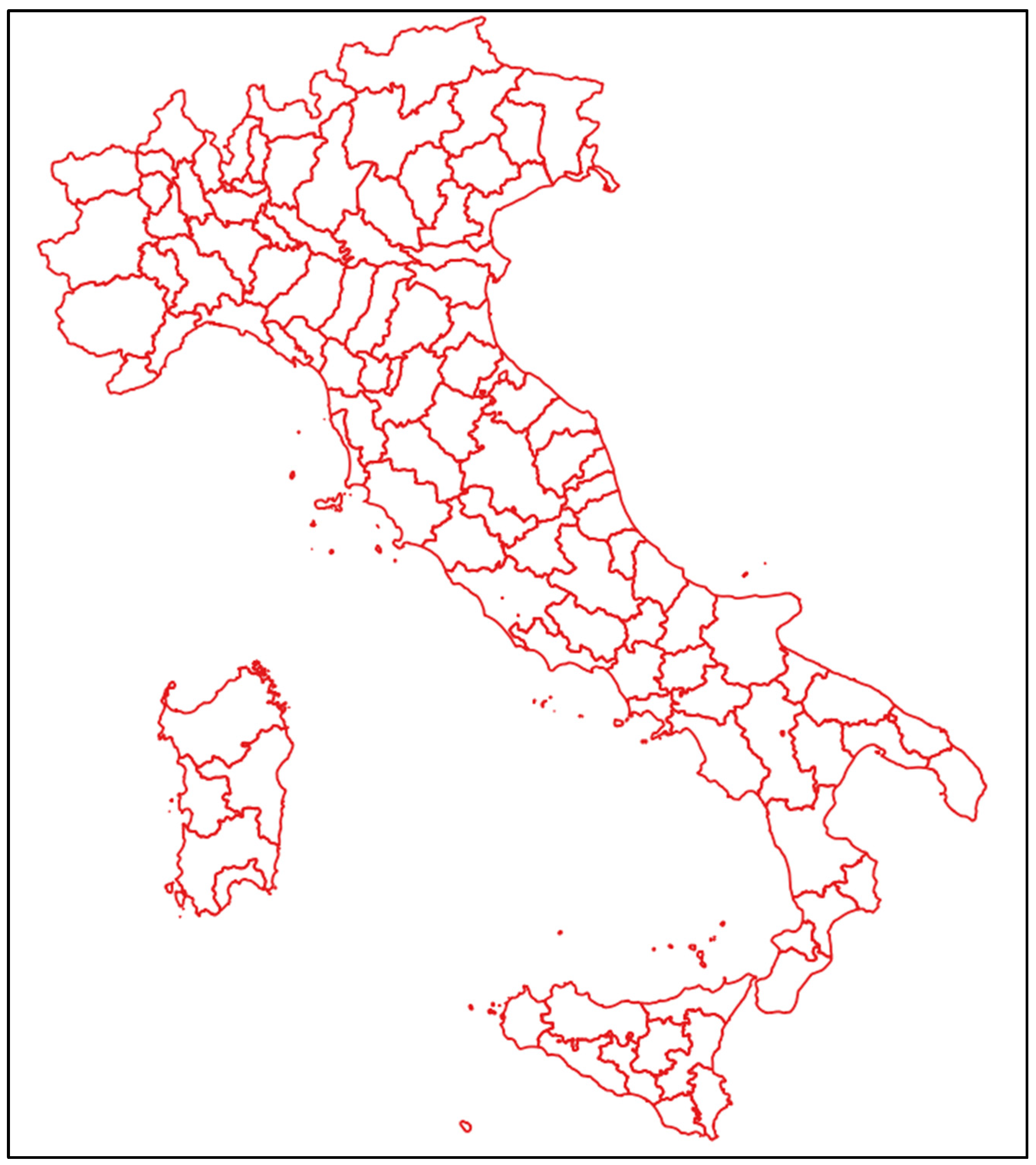
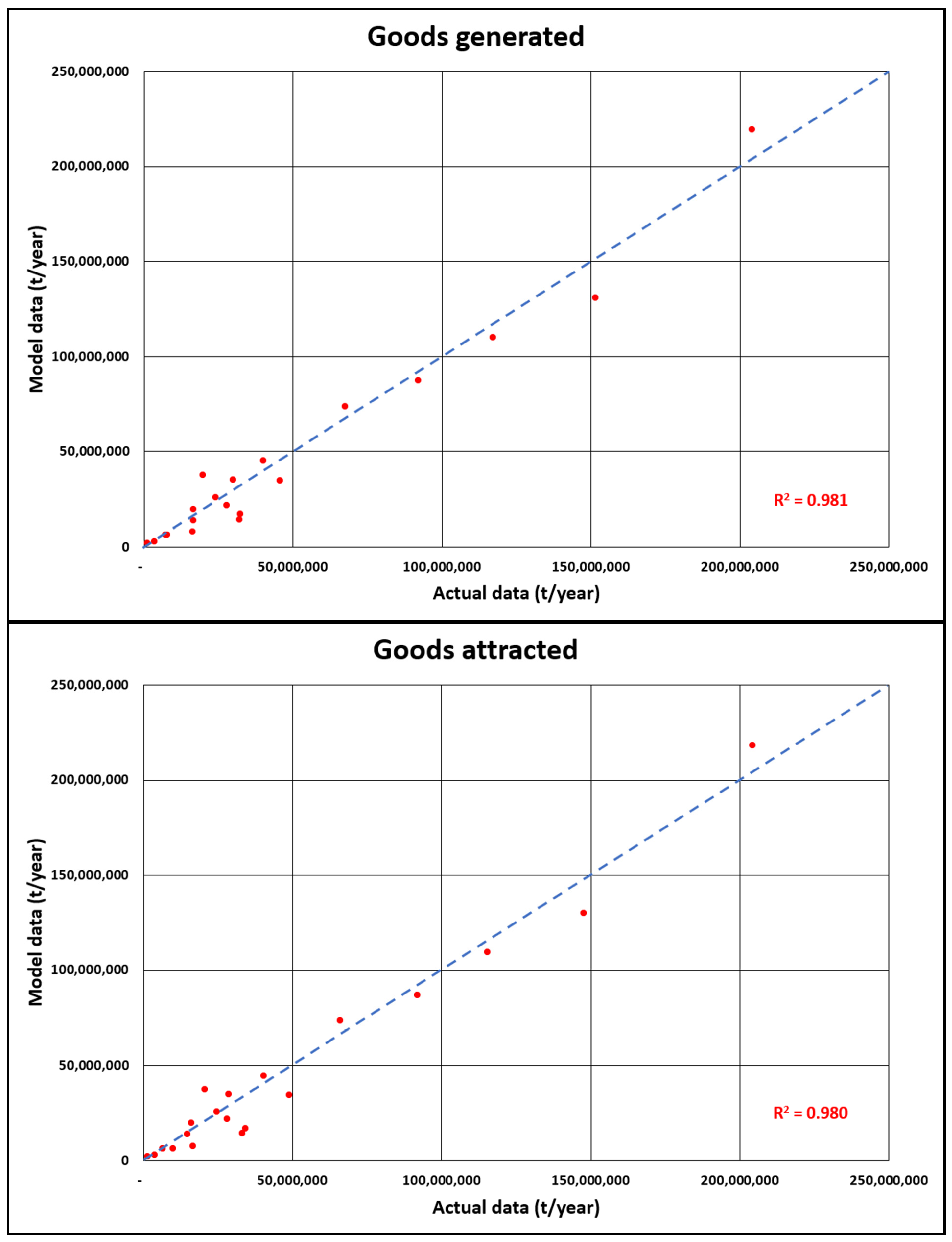
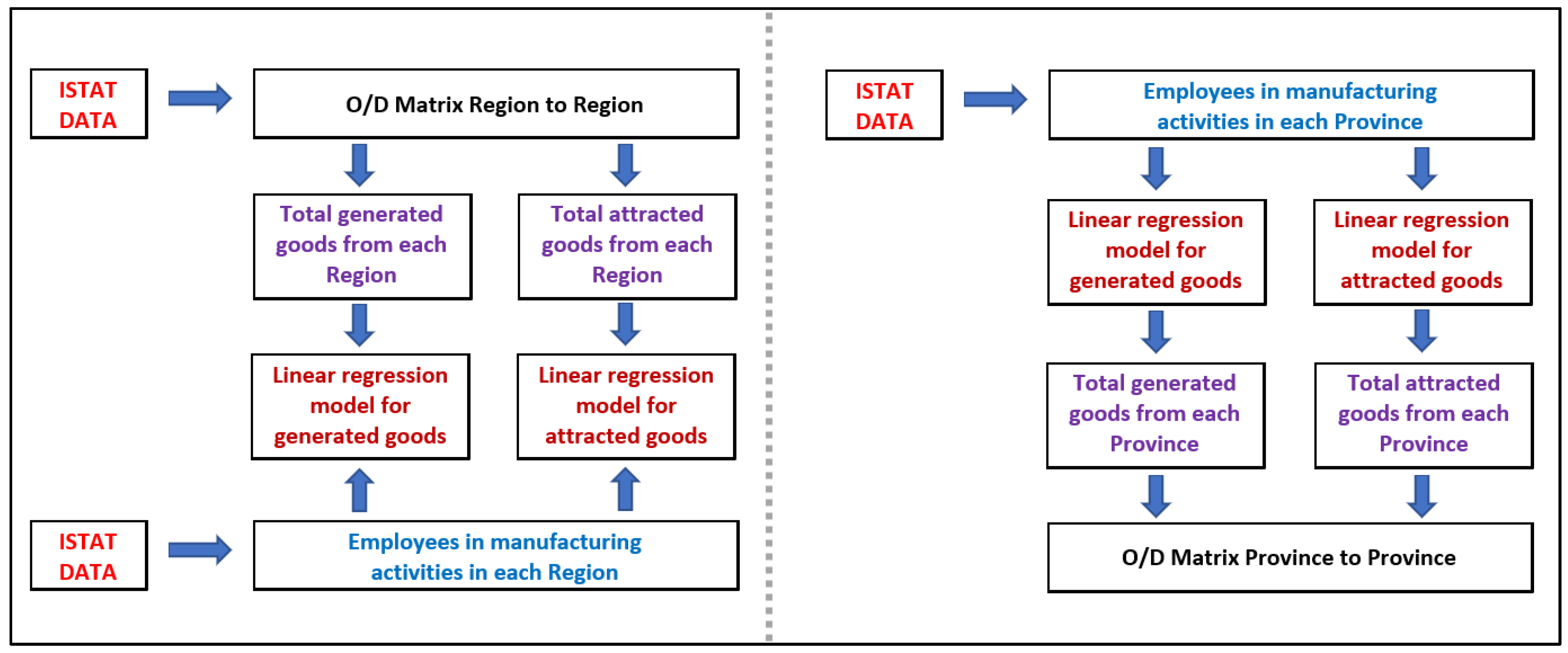
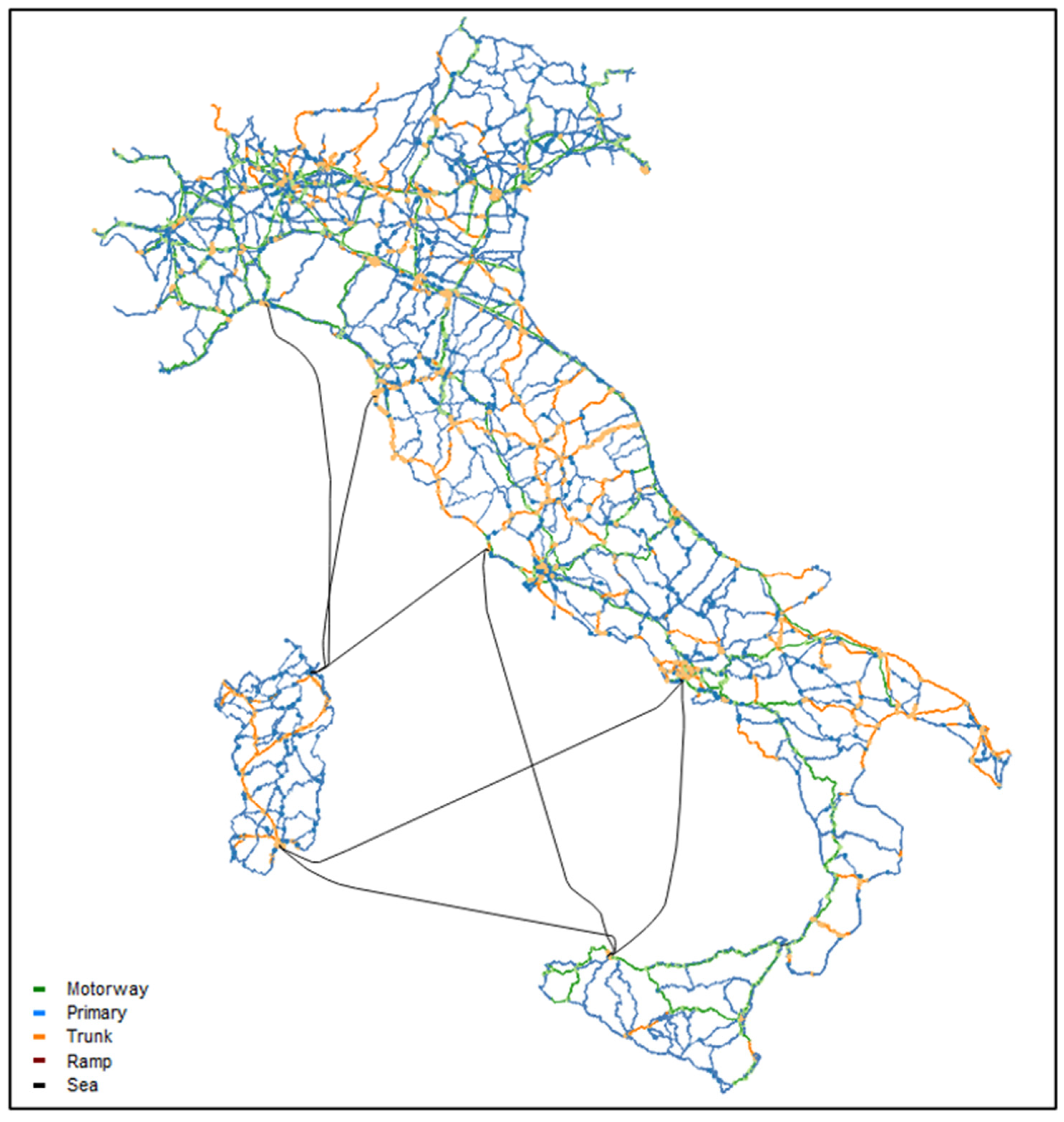
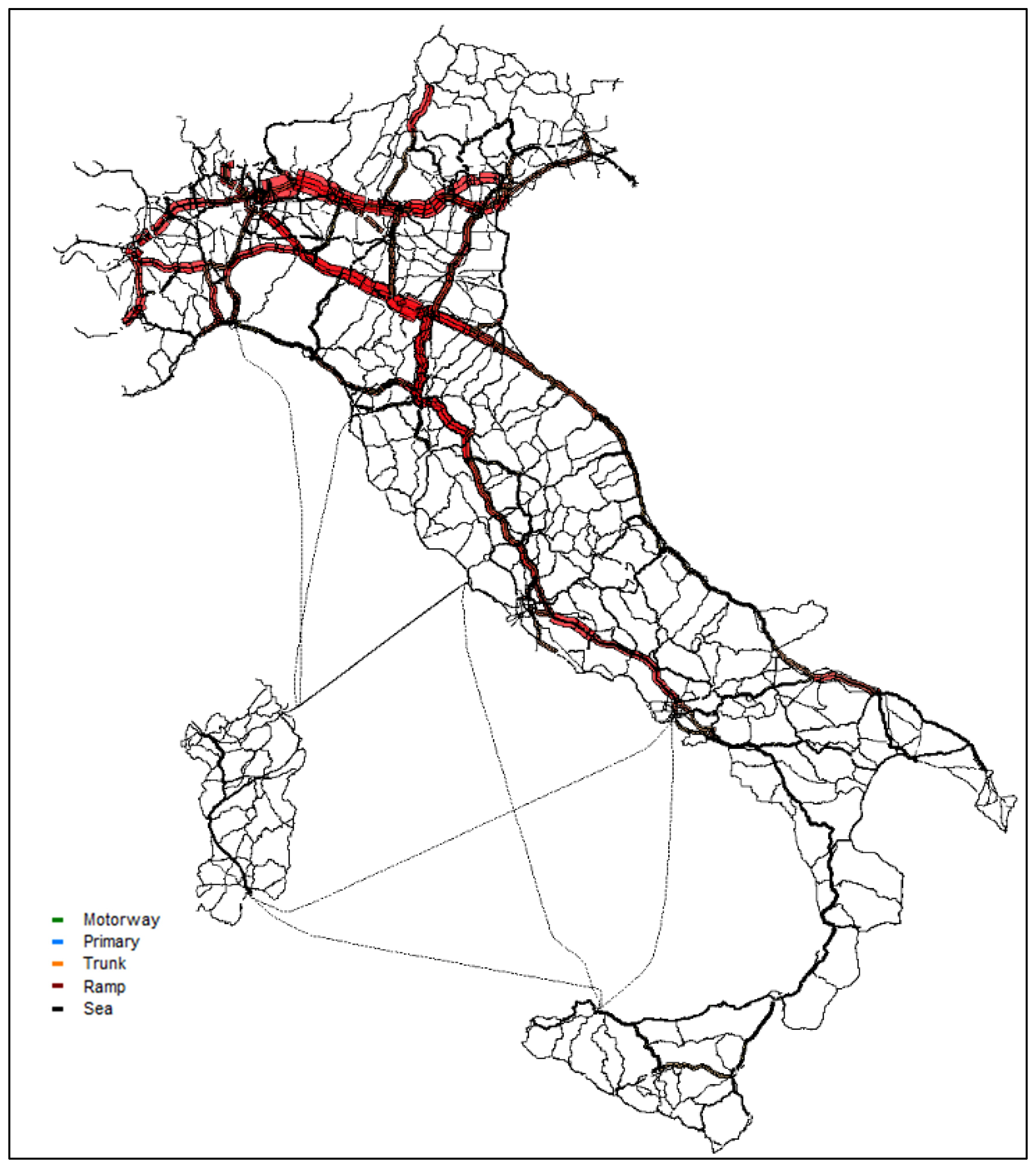
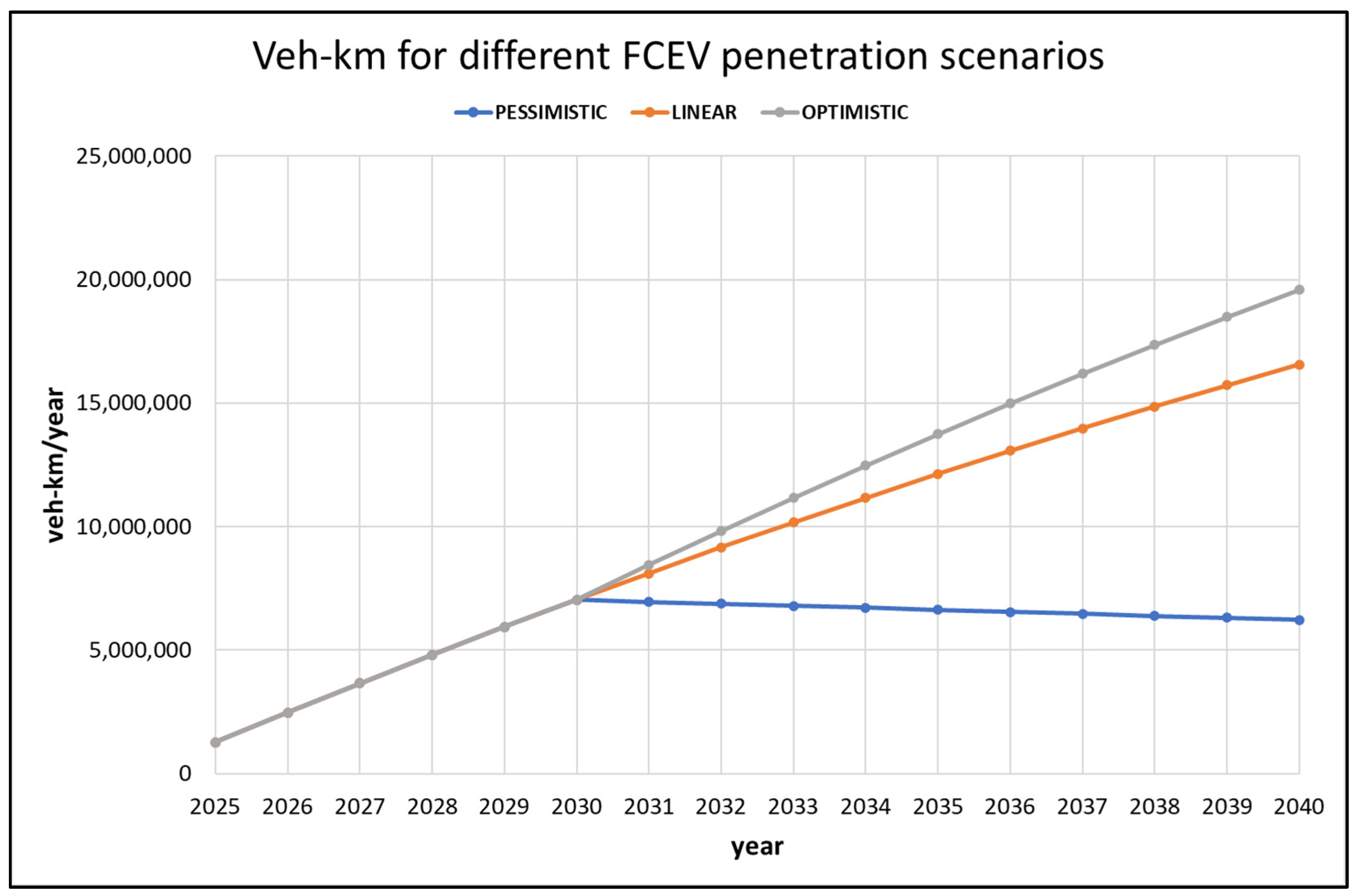
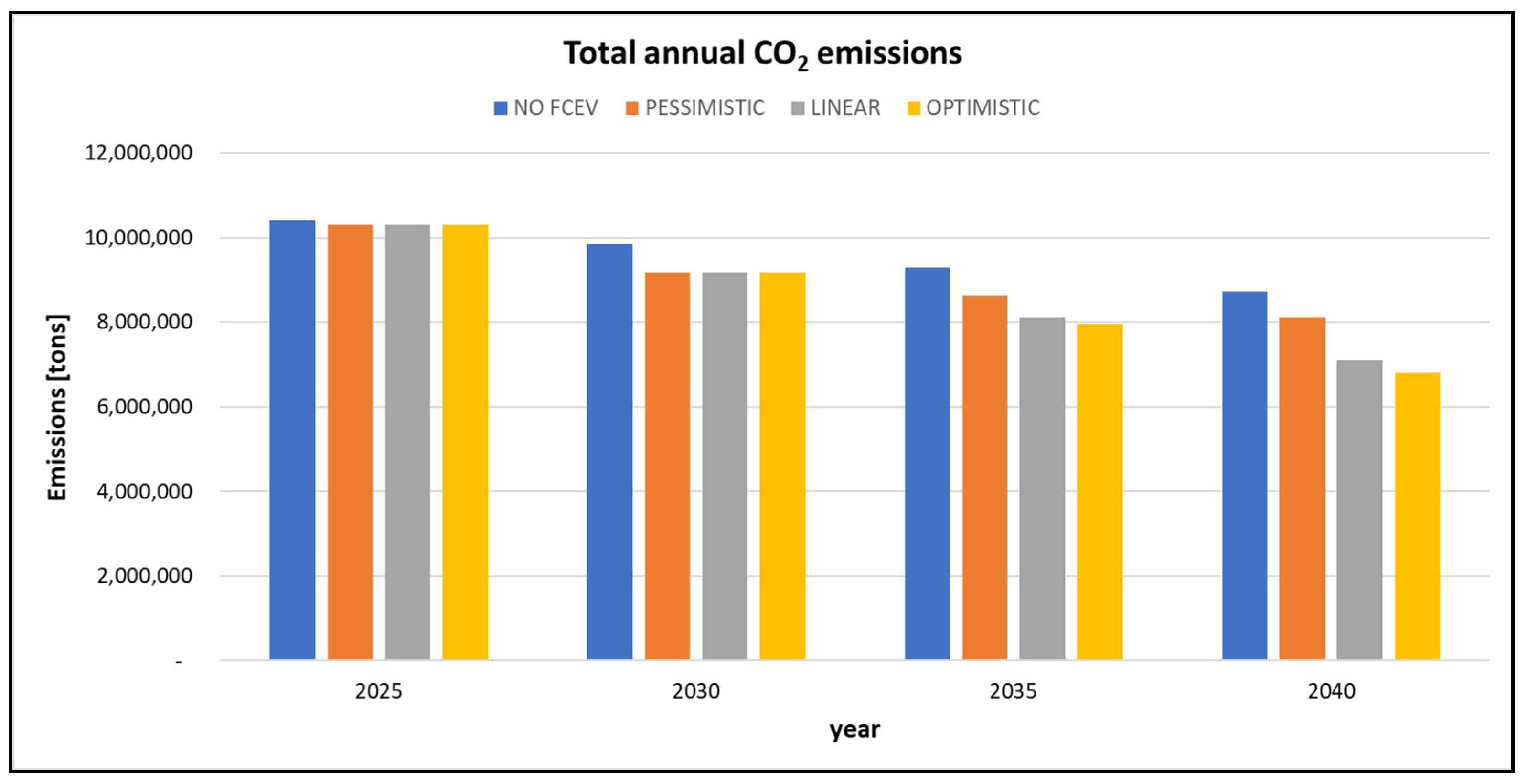
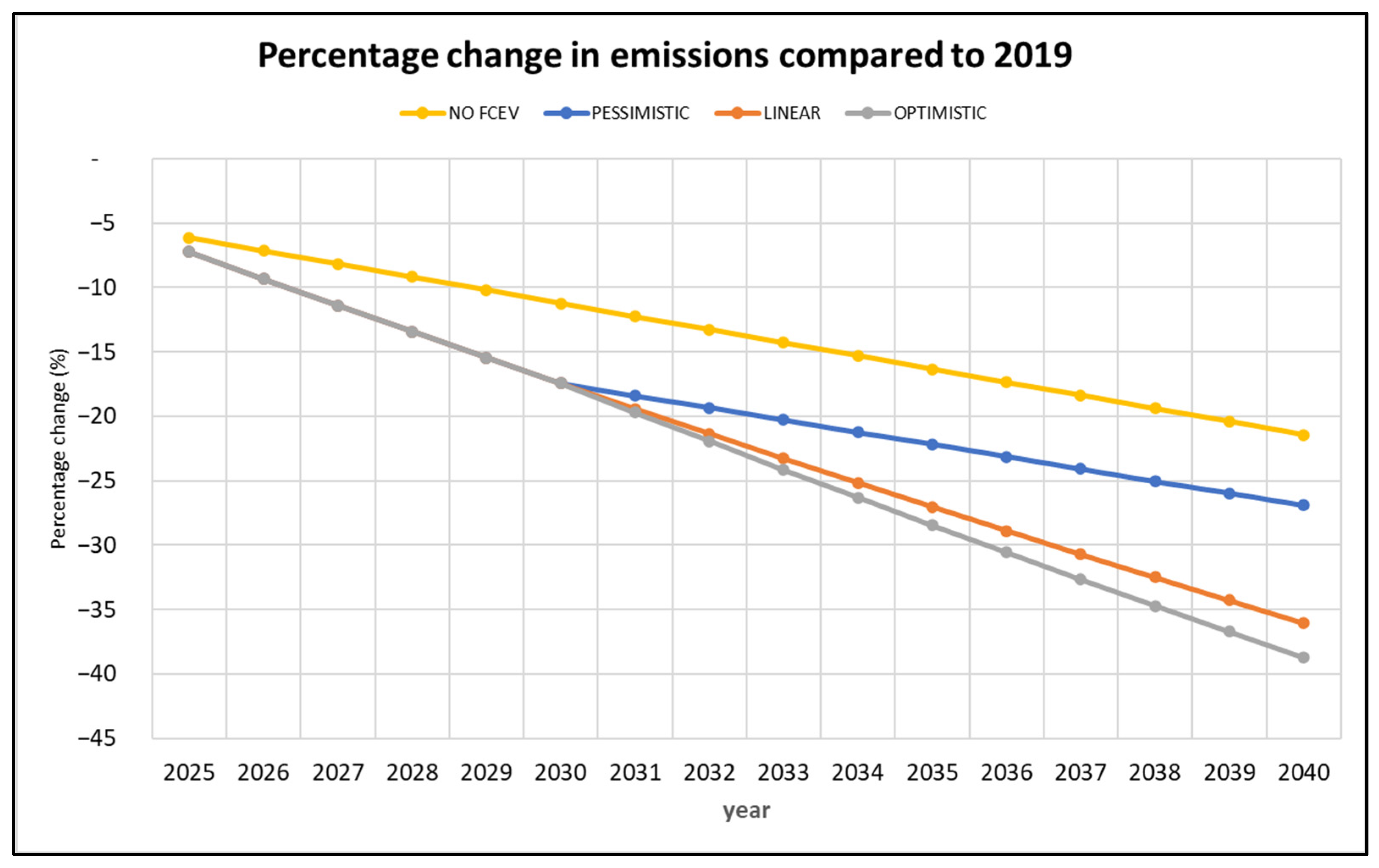

| Region | Generated Goods [t/Year] | Attracted Goods [t/Year] | Employees in Manufacturing Activities |
|---|---|---|---|
| Piemonte | 92,171,837 | 91,943,760 | 359,056 |
| Valle d’Aosta | 1,117,068 | 1,374,407 | 9316 |
| Liguria | 31,968,665 | 33,122,971 | 59,139 |
| Lombardia | 204,170,787 | 204,251,818 | 903,826 |
| Trentino Alto Adige | 32,391,364 | 34,206,166 | 69,943 |
| Veneto | 151,512,857 | 147,635,451 | 537,797 |
| Friuli-Venezia Giulia | 24,120,398 | 24,578,484 | 106,808 |
| Emilia-Romagna | 117,100,836 | 115,411,530 | 452,621 |
| Toscana | 67,444,868 | 66,024,129 | 303,266 |
| Umbria | 16,718,504 | 14,908,460 | 57,678 |
| Marche | 19,834,810 | 20,630,934 | 154,771 |
| Lazio | 45,733,494 | 49,006,578 | 9182 |
| Abruzzo | 16,733,577 | 16,237,471 | 3439 |
| Molise | 3,550,801 | 3,815,597 | 77,509 |
| Campania | 39,982,681 | 40,426,876 | 24,540 |
| Puglia | 29,949,807 | 28,541,964 | 28,952 |
| Basilicata | 7,294,685 | 6,552,522 | 81,727 |
| Calabria | 7,736,544 | 10,085,013 | 9330 |
| Sicilia | 27,832,117 | 28,222,311 | 2829 |
| Sardegna | 16,348,194 | 16,737,452 | 26,001 |
| Coefficient | 243.09 | 241.52 | |
| Statistical tests | |||
| R2 | 0.981 | 0.980 | |
| F | ≅0 | ≅0 | |
| t-student | 31.04 | 30.61 |
| Links | Number | km |
|---|---|---|
| Sea links | 6 | 480 |
| Motorways | 4242 | 22,677 |
| Primary roads | 14,495 | 15,641 |
| Ramps | 4130 | 1027 |
| Trunk roads | 2726 | 9741 |
| Total | 25,599 | 49,566 |
| Link | Average Speed [km/h] |
|---|---|
| Motorway | 85 |
| Primary road | 65 |
| Ramp | 30 |
| Trunk road | 70 |
| Connector | 10 |
| Links | Million Veh-km/Year |
|---|---|
| Motorways | 11,882 |
| Primary roads | 2036 |
| Ramps | 209 |
| Trunk roads | 1339 |
| Total | 15,506 |
| Year | No-FCEV [t/Year] | Pessimistic [t/Year] | Linear [t/Year] | Optimistic [t/Year] |
|---|---|---|---|---|
| 2025 | 10,426,590 | 10,301,470 | 10,301,470 | 10,301,470 |
| 2026 | 10,313,305 | 10,069,911 | 10,069,911 | 10,069,911 |
| 2027 | 10,200,021 | 9,840,980 | 9,840,980 | 9,840,980 |
| 2028 | 10,086,737 | 9,614,678 | 9,614,678 | 9,614,678 |
| 2029 | 9,973,453 | 9,391,003 | 9,391,003 | 9,391,003 |
| 2030 | 9,860,169 | 9,169,957 | 9,169,957 | 9,169,957 |
| 2031 | 9,746,884 | 9,064,602 | 8,951,539 | 8,918,399 |
| 2032 | 9,633,600 | 8,959,248 | 8,735,749 | 8,670,240 |
| 2033 | 9,520,316 | 8,853,894 | 8,522,587 | 8,425,480 |
| 2034 | 9,407,032 | 8,748,539 | 8,312,053 | 8,184,118 |
| 2035 | 9,293,747 | 8,643,185 | 8,104,148 | 7,946,154 |
| 2036 | 9,180,463 | 8,537,831 | 7,898,871 | 7,711,589 |
| 2037 | 9,067,179 | 8,432,477 | 7,696,222 | 7,480,423 |
| 2038 | 8,953,895 | 8,327,122 | 7,496,201 | 7,252,655 |
| 2039 | 8,840,611 | 8,221,768 | 7,298,808 | 7,028,285 |
| 2040 | 8,727,326 | 8,116,414 | 7,104,044 | 6,807,315 |
| Year | Pessimistic [t/Year] | Linear [t/Year] | Optimistic [t/Year] |
|---|---|---|---|
| 2025 | 125,119 | 125,119 | 125,119 |
| 2026 | 243,394 | 243,394 | 243,394 |
| 2027 | 359,041 | 359,041 | 359,041 |
| 2028 | 472,059 | 472,059 | 472,059 |
| 2029 | 582,450 | 582,450 | 582,450 |
| 2030 | 690,212 | 690,212 | 690,212 |
| 2031 | 682,282 | 795,346 | 828,485 |
| 2032 | 674,352 | 897,852 | 963,360 |
| 2033 | 666,422 | 997,729 | 1,094,836 |
| 2034 | 658,492 | 1,094,978 | 1,222,914 |
| 2035 | 650,562 | 1,189,600 | 1,347,593 |
| 2036 | 642,632 | 1,281,593 | 1,468,874 |
| 2037 | 634,703 | 1,370,957 | 1,586,756 |
| 2038 | 626,773 | 1,457,694 | 1,701,240 |
| 2039 | 618,843 | 1,541,802 | 1,812,325 |
| 2040 | 610,913 | 1,623,283 | 1,920,012 |
| Total | 8,938,248 | 14,723,109 | 16,418,671 |
| Vehicle Category | Technology | Fuel Consumption [g/Vehicle-km] | Fuel Consumption [L/Vehicle-km] | Vehicle-km Share |
|---|---|---|---|---|
| 7.5–16 tons | Conventional | 182 | 0.219 | 0.44% |
| EURO 1 and following | 155 | 0.187 | 15.02% | |
| 16–32 tons | Conventional | 251 | 0.302 | 1.81% |
| EURO 1 and following | 210 | 0.253 | 82.28% | |
| >32 tons | Conventional | 297 | 0.358 | 0.03% |
| EURO 1 and following | 251 | 0.302 | 0.43% | |
| Average consumption [l/vehicle-km] | 0.244 | |||
| Year | No-FCEV [Million L/Year] | Pessimistic [Million L/Year] | Linear [Million L/Year] | Optimistic [Million L/Year] |
|---|---|---|---|---|
| 2025 | 3543 | 3501 | 3501 | 3501 |
| 2026 | 3505 | 3422 | 3422 | 3422 |
| 2027 | 3466 | 3344 | 3344 | 3344 |
| 2028 | 3428 | 3267 | 3267 | 3267 |
| 2029 | 3389 | 3191 | 3191 | 3191 |
| 2030 | 3351 | 3116 | 3116 | 3116 |
| 2031 | 3312 | 3080 | 3042 | 3031 |
| 2032 | 3274 | 3045 | 2969 | 2946 |
| 2033 | 3235 | 3009 | 2896 | 2863 |
| 2034 | 3197 | 2973 | 2825 | 2781 |
| 2035 | 3158 | 2937 | 2754 | 2700 |
| 2036 | 3120 | 2901 | 2684 | 2621 |
| 2037 | 3081 | 2866 | 2615 | 2542 |
| 2038 | 3043 | 2830 | 2547 | 2465 |
| 2039 | 3004 | 2794 | 2480 | 2388 |
| 2040 | 2966 | 2758 | 2414 | 2313 |
| Year | Pessimistic [Million L/Year] | Linear [Million L/Year] | Optimistic [Million L/Year] |
|---|---|---|---|
| 2025 | 43 | 43 | 43 |
| 2026 | 83 | 83 | 83 |
| 2027 | 122 | 122 | 122 |
| 2028 | 160 | 160 | 160 |
| 2029 | 198 | 198 | 198 |
| 2030 | 235 | 235 | 235 |
| 2031 | 232 | 270 | 282 |
| 2032 | 229 | 305 | 327 |
| 2033 | 226 | 339 | 372 |
| 2034 | 224 | 372 | 416 |
| 2035 | 221 | 404 | 458 |
| 2036 | 218 | 436 | 499 |
| 2037 | 216 | 466 | 539 |
| 2038 | 213 | 495 | 578 |
| 2039 | 210 | 524 | 616 |
| 2040 | 208 | 552 | 652 |
| Total | 3038 | 5003 | 5580 |
Publisher’s Note: MDPI stays neutral with regard to jurisdictional claims in published maps and institutional affiliations. |
© 2022 by the authors. Licensee MDPI, Basel, Switzerland. This article is an open access article distributed under the terms and conditions of the Creative Commons Attribution (CC BY) license (https://creativecommons.org/licenses/by/4.0/).
Share and Cite
Gallo, M.; Marinelli, M. The Impact of Fuel Cell Electric Freight Vehicles on Fuel Consumption and CO2 Emissions: The Case of Italy. Sustainability 2022, 14, 13455. https://doi.org/10.3390/su142013455
Gallo M, Marinelli M. The Impact of Fuel Cell Electric Freight Vehicles on Fuel Consumption and CO2 Emissions: The Case of Italy. Sustainability. 2022; 14(20):13455. https://doi.org/10.3390/su142013455
Chicago/Turabian StyleGallo, Mariano, and Mario Marinelli. 2022. "The Impact of Fuel Cell Electric Freight Vehicles on Fuel Consumption and CO2 Emissions: The Case of Italy" Sustainability 14, no. 20: 13455. https://doi.org/10.3390/su142013455
APA StyleGallo, M., & Marinelli, M. (2022). The Impact of Fuel Cell Electric Freight Vehicles on Fuel Consumption and CO2 Emissions: The Case of Italy. Sustainability, 14(20), 13455. https://doi.org/10.3390/su142013455









